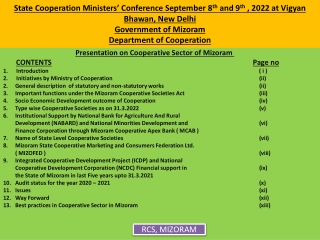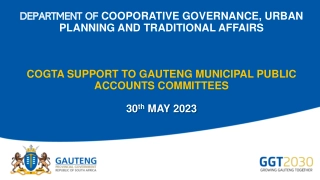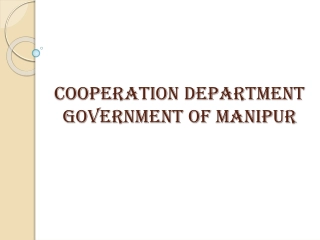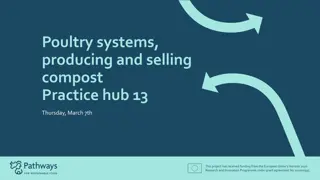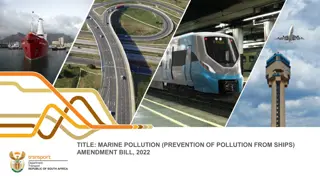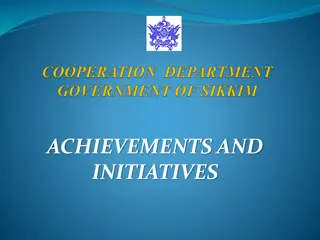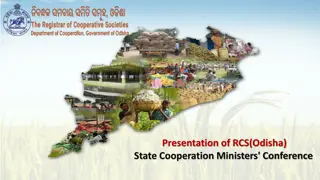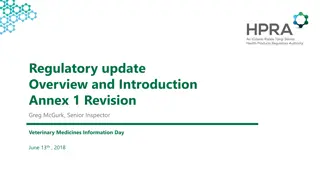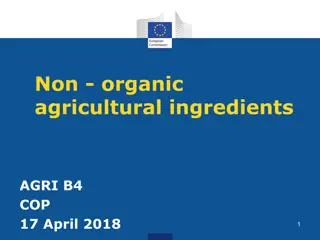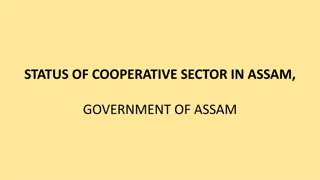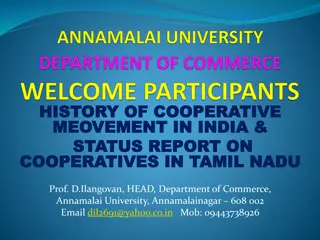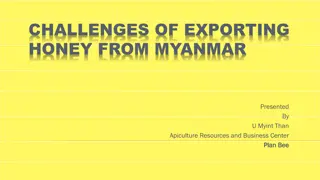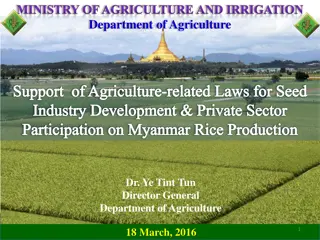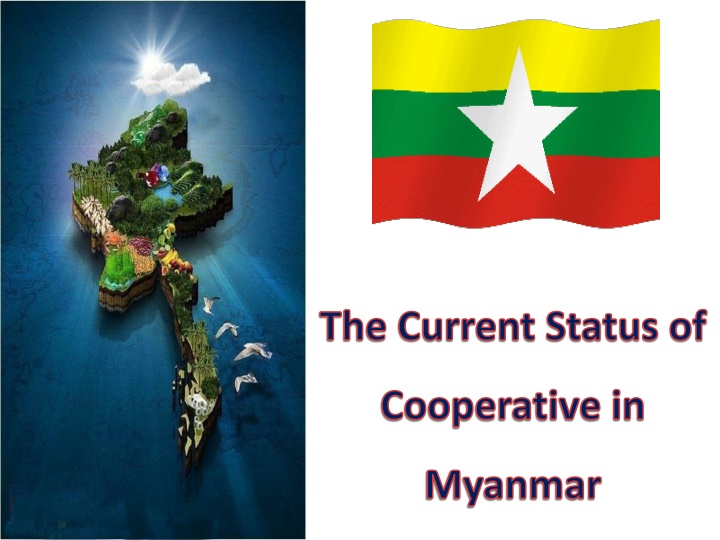
Cooperatives in Myanmar: Current Status and Development Efforts
Learn about the current status of cooperatives in Myanmar as of March 2017, including the Ministry of Agriculture's vision and objectives for promoting sustainable agricultural practices and improving rural livelihoods through cooperative societies. Explore the main functions and policies supporting cooperative development in the country.
Download Presentation

Please find below an Image/Link to download the presentation.
The content on the website is provided AS IS for your information and personal use only. It may not be sold, licensed, or shared on other websites without obtaining consent from the author. If you encounter any issues during the download, it is possible that the publisher has removed the file from their server.
You are allowed to download the files provided on this website for personal or commercial use, subject to the condition that they are used lawfully. All files are the property of their respective owners.
The content on the website is provided AS IS for your information and personal use only. It may not be sold, licensed, or shared on other websites without obtaining consent from the author.
E N D
Presentation Transcript
The Current Status of Cooperative in Myanmar
Ministry of Agriculture, Livestock and Irrigation Central Cooperative Department Cooperative Society (1) Region/State Union of Cooperative Syndicates (22) Region and State Cooperative Department (15) Township Cooperative Syndicate (464) Township Cooperative Department (306) Primary Cooperative Society ( 40152) Organizing Educating Regulating Total - 40639 Over ( 4.23million) As of (31.3.2017)
Vision The Vision of Ministry of Agriculture, Livestock and Irrigation are as follows; An inclusive, competitive, secured food and nutrition and sustainable agricultural system contributing to the socio- economic well-being and rural people and further development of the national economy. 3
Objectives To upgrade the agricultural sector by organizing farmers associations and cooperatives inclusive of small holders and subsistence farmers with promotion of gender role. To seek technical assistance and mobilize the financial resources from local and international agencies in support of crops, livestock, fisheries and rural development in the agriculture sector. To improve the livelihood and income generation of the rural people through the development of cooperative enterprises and system. 4
Cooperative Society and Cooperative System Development Policy 1. To support for further development of cooperative enterprise in addition to the existing microfinance schemes, acquisition of farm machineries and equipment, and inputs with installment payment. 2. To support the formation of cooperative societies, monitoring and evaluation of these societies in accordance with Cooperatives Laws and Procedures, and to conduct Cooperative Education Trainings. 3. To uplift the economic, education , health, and living standard of family members of cooperative societies, in collaboration with relevant organizations. 4. To link with international cooperative organizations for productive collaboration. 5. To build capacity of cooperative societies focusing on production, service and trade aspects. 5
Three Main Functions of Cooperative Department Organizing Educating Regulating 6
Current Situation of Organized Cooperative Societies As of (31-3-2017) No . Member Society Type of Society Society Members Central Cooperative Society 1. 1 448 Union Cooperative Syndicates 2. 22 515 Township Cooperative Syndicates 3. 464 20927 Primary Cooperative Society 4. 40152 4239687 Total 40639 21890 4239687 7
Human Resources Programme for Cooperative Education Sector Ministry of Agriculture, Livestock and Irrigation Cooperative Department Three Four Two Two Cooperative Cooperative Cooperative Cooperative Commercial Training Universities Colleges Training Schools Schools 8
Cooperative Educating and Awareness Trainings for BODs and Society Staff Advanced Cooperative Refresher Course for BODs and Societies staff Cooperative Refresher Course for BODs and Societies staff (On Job Training) Trainings for Cooperative Department Staff Advanced Cooperative Training for Officers Advanced Cooperative Training for Staff Basic Cooperative Training for Staff Capacity Building Trainings for Trainers Basic/ Intermediate/ Advanced Level Accounting and Office Skilled Training Cooperative Refresher Course for Staff from Regions and States Computer Trainings Other Trainings Book Keeping, Accounting Training and Computer Accounting 9
Regulating to the Cooperatives The Cooperative Department has been regulating to all of the cooperative societies as follows;- Cooperative Member Auditor always audits monthly Bi-Annual and Annual Auditing In auditing, only Cooperative Department (Or) Audit Firm that approved by the government 10
Action Plan 1. Organizing the Cooperative Societies 2. Microfinance 3. Selling the farming machines with long term hire purchase system 4. Land Consolidation for the small holders farmers as transforming from conventional farming to mechanized farming system 5. Establishing the Agri-Support Service Cooperative Society 6. Inputs Distribution Business for Agriculture Sector 7. Seeking the financial capital 11
Functions of Cooperative Production Services Trade - Microfinance - Hired Purchase System - Health - Transport - Hotel, Motel, Guest house - Agriculture - Livestock - Industry - Export - Handicraft Shop - Selling and buying 12
Why We Need Microfinance Low interest rate < 2.5% per month (MF Law, 2011) Without collateral Can earn on saving money Can set up small business and make income generation Consequently, MF can actually help the development of the socioeconomic lives of grass roots level people in mostly rural areas 13
Current Situation of Microfinance Implementation (As of 31-3-2017) (Kyat Million) Total Disbursement 8 9448.336 20383.292 4768.329 5047.266 8688.340 79398.729 10550.567 91454.664 72521.079 94948.363 21102.537 10753.522 38840.542 53015.731 96900.284 Region/ States 2 Townshi p 3 No Society Member Share Saving 1 1 Naypyitaw 2 Kachin 3 Kayah 4 Kayin 5 Chin 6 Sagaing 7 Taninthari 8 Bago 9 Magway 10Mandalay 11Mon 12Rakhine 13Yangon 14Shan 15Ayeyarwady 4 5 6 395.231 596.371 123.054 170.066 207.057 2527.681 253.352 2549.149 2476.767 3260.397 635.223 486.133 1077.888 1714.372 3380.533 7 8 542 743 223 442 476 5200 354 6419 5044 4014 774 1078 1457 1790 6494 66960 71747 19185 32880 27421 416293 41189 472046 406642 566493 92038 67989 215021 181515 624031 4641.852 7030.464 2415.461 3051.443 2890.950 35765.793 4548.611 31957.902 23584.573 36079.568 7966.287 3613.827 15108.238 24541.999 36356.678 13 6 7 9 34 10 28 25 28 10 17 43 43 26 307 35050 3301450 19853.274 617821.581 Total 239553.646
Selling the Farming Machines and other machines with Hire Purchase System (As of 31-3-2017) Type of Machines Value (Kyat Million) Amount (Unit) Owned (Unit) Agriculture Machines 23930 132943.949 3255 Business Used Machines 24283 21072.503 13076 Fishery Used Machines 14916 2283.817 8788 Total 63129 156300.269 25119 15
Challenges Government Support People Trust on Cooperatives Tech Assistances Cooperative Awareness No modern IT Cooperative Practice Trade and Production Cooperatives Microfinance itself 16
Recommendations Cooperative Awareness in Rural Areas Capacity Building and Development Trainings Knowledge Sharing Programs Institutionalization 17
Thank You 18


